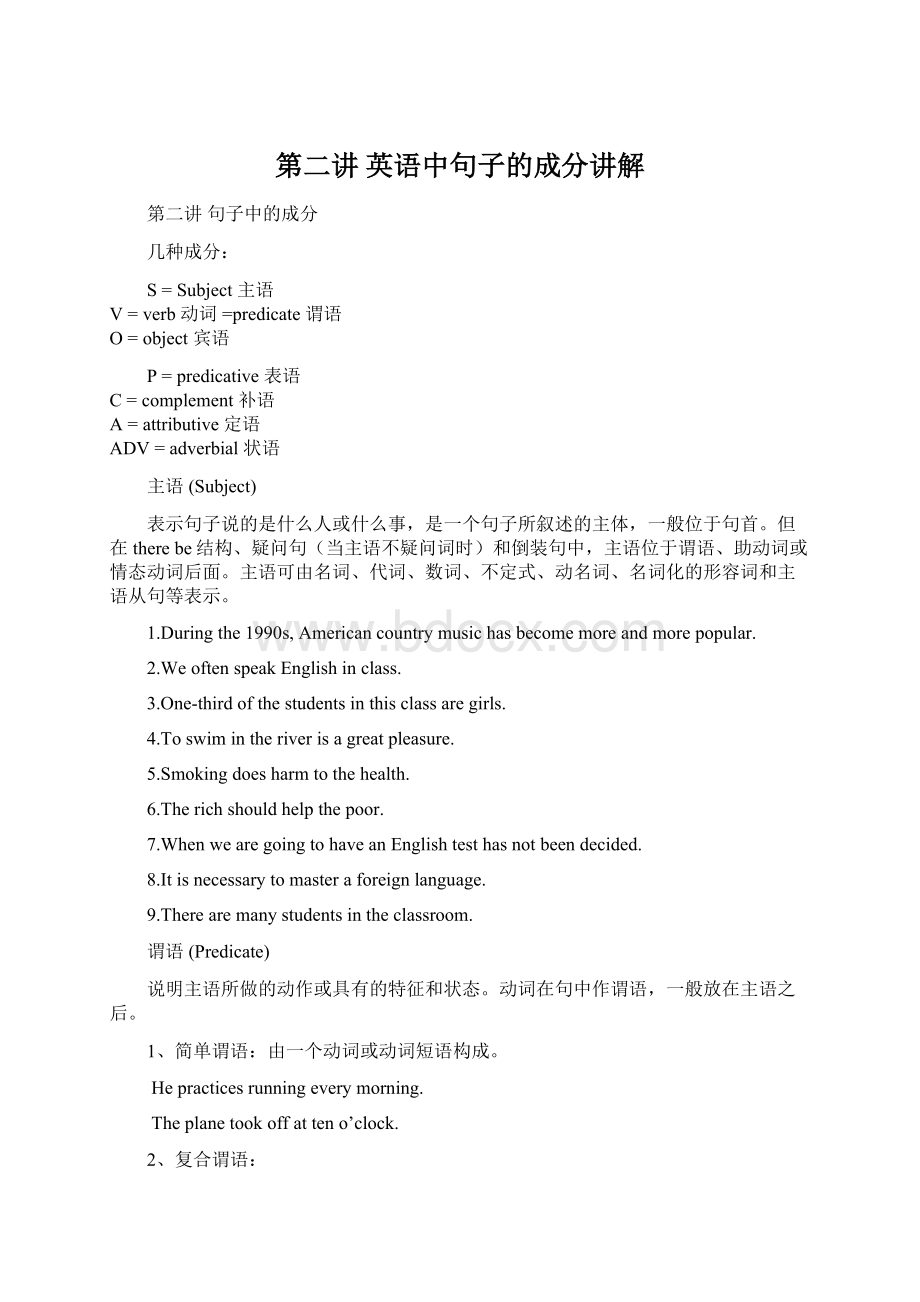第二讲 英语中句子的成分讲解.docx
《第二讲 英语中句子的成分讲解.docx》由会员分享,可在线阅读,更多相关《第二讲 英语中句子的成分讲解.docx(9页珍藏版)》请在冰豆网上搜索。

第二讲英语中句子的成分讲解
第二讲句子中的成分
几种成分:
S=Subject主语
V=verb动词=predicate谓语
O=object宾语
P=predicative表语
C=complement补语
A=attributive定语
ADV=adverbial状语
主语(Subject)
表示句子说的是什么人或什么事,是一个句子所叙述的主体,一般位于句首。
但在therebe结构、疑问句(当主语不疑问词时)和倒装句中,主语位于谓语、助动词或情态动词后面。
主语可由名词、代词、数词、不定式、动名词、名词化的形容词和主语从句等表示。
1.Duringthe1990s,Americancountrymusichasbecomemoreandmorepopular.
2.WeoftenspeakEnglishinclass.
3.One-thirdofthestudentsinthisclassaregirls.
4.Toswimintheriverisagreatpleasure.
5.Smokingdoesharmtothehealth.
6.Therichshouldhelpthepoor.
7.WhenwearegoingtohaveanEnglishtesthasnotbeendecided.
8.Itisnecessarytomasteraforeignlanguage.
9.Therearemanystudentsintheclassroom.
谓语(Predicate)
说明主语所做的动作或具有的特征和状态。
动词在句中作谓语,一般放在主语之后。
1、简单谓语:
由一个动词或动词短语构成。
Hepracticesrunningeverymorning.
Theplanetookoffatteno’clock.
2、复合谓语:
(1)由情态动词加动词原形构成。
如:
Youmaykeepthebookfortwoweeks.
(2)由助动词加动词原形,现在分词,过去分词构成。
如:
DoyouspeakEnglish?
Theyareworkinginafield.
Hehascaughtabadcold.
(3)由系动词加表语构成。
如:
Wearestudents.
注意:
谓语与主语在人称与数方面要保持一致。
表语(Predicative)
用以说明主语的性质、特征、状态与身份,它一般位于系动词(如be,become,get,look,grow,turn,seem等)之后。
表语一般由名词、代词、形容词、数词、副词、不定式、动名词、分词、介词短语及表语从句表示。
1.OurteacherofEnglishisanAmerican.(名词)
2.Isityours?
(代词)
3.Theweatherhasturnedcold.(形容词)
4.Thespeechisexciting.(分词)
5.Threetimessevenistwentyone?
(数词)
6.HisjobistoteachEnglish.(不定式)
7.Hishobbyisplayingfootball.(动名词)
8.Themeetingisofgreatimportance.(介词短语)
9.Timeisup.Theclassisover.(副词)
10.Thetruthisthathehasneverbeenabroad.(表语从句)
宾语(Object)
表示动作的对象或承受者,一般位于及物动词和介词后面。
1.Heisdoinghishomework.
2.Theheavyrainpreventedmefromcomingtoschoolontime.
3.Howmanydictionariesdoyouhave?
Ihavefive.
宾语种类:
(1)双宾语(间接宾语+直接宾语)
Lendmeyourdictionary,please.
To:
write,tell,pass,give,send,promise,show,hand,read,tell,bring,throw如:
HesentthenoveltoWilliamyesterday.
For:
leave,buy,build,choose,cook,draw,find,get,order,post,save等,例如:
Sheboughtagiftforhermother.
(2)复合宾语(宾语+宾补)
Theyelectedhimtheirmonitor.
下列动词只能接不定式做宾语
ask,agree,care,choose,demand,dare,decide,expect,fail,help,hope,learn,manage,offer,plan,prepare,pretend,promise,refuse,want,wish,desire等,如:
Herefusedtolendmehisbike.
下列动词只能接动名词做宾语
admit,avoid,advise,consider,enjoy,excuse,escape,finish,imagine,mind,practise,suggest等,
如:
Johnhasadmittedbreakingthewindow.
下列动词既可接不定式,也可接动名词做宾语,但意义不同
mean,try,remember,forget,regret等。
forgettodo表示“未发生的动作”,
forgetdoing表示“已完成的动作”。
如:
Don'tforgettocomehereearliertomorrow.(还没来)
Iforgotreturningthebooktohim.(书已还给他了)
宾语补足语(ObjectComplement)
用于补充说明宾语的动作,一般位于宾语之后,宾语与宾语补足语一起构成复合宾语。
需接复合宾语的动词有:
tell,let,help,teach,ask,see,have,order,make等。
“宾补”一般可由名词、形容词、副词、不定式、分词、介词短语和从句充当。
1.HisfathernamedhimXiaoming.
2.Theypaintedtheirboatwhite.
3.Letthefreshairin.
4.Youmustn’tforcehimtolendhismoneytoyou.
5.Wesawherenteringtheroom.
6.Wefoundeverythinginthelabingoodorder.
7.Wewillsoonmakeourcitywhatyourcityisnow.
定语(Attribute)
修饰名词或代词的词、短语或从句称为定语(Attribute)。
1.Guilinisabeautifulcity.(形容词)
2.Chinaisadevelopingcountry;Americaisadevelopedcountry.(分词)
3.Therearethirtywomenteachersinourschool.(名词)
4.HisrapidprogressinEnglishmadeussurprised.(代词)
5.Ourmonitorisalwaysthefirsttoentertheclassroom.(不定式短语)
6.Theteachingplanfornexttermhasbeenworkedout.(动名词)
7.HeisreadinganarticleabouthowtolearnEnglish.(介词短语)
8.Sheisthegirlwhosingsbestinmyclass.(定语从句)
状语(Adverbial)
修饰动词、形容词、副词或整个句子,说明动作或状态特征的句子成分,叫做状语(Adverbial)。
1.Lighttravelsmostquickly.
2.Hehaslivedinthecityfortenyears.
3.Heisproudtohavepassedthenationalcollegeentranceexamination.
4.Heisintheroommakingamodelplane.
5.Waitaminute.
6.Onceyoubegin,youmustcontinue.
状语类型:
1.Howaboutmeetingagainatsix?
(时间状语)
2.Lastnightshedidn’tgotothedancepartybecauseoftherain.(原因状语)
3.Ishallgothereifitdoesn’train.(条件状语)
4.MrSmithlivesonthethirdfloor.(地点状语)
5.Sheputtheeggsintothebasketwithgreatcare.(方式状语)
6.Inordertocatchupwiththeothers,Imustworkharder.(目的状语)
7.Hewassotiredthathefellasleepimmediately.(结果状语)
8.Sheworksveryhardthoughsheisold.(让步状语)
9.Iamtallerthanheis.(比较状语)
10.Shecameinwithadictionaryinherhand.(伴随状语)
同位语(Appositive)
对前面的名词或代词做进一步的解释,通常由名词、数词、代词或从句担任,如:
ThisisMr.Zhou,ourheadmaster.
插入语(Parenthesis)
对一句话做一些附加的解释,通常有tobehonest,Ithink(suppose,believe---)等,如:
Tobefrank,Idon’tquiteagreewithyou.
各种词类及其在句子中的作用:
1.Nouns(n.)名词:
主语(S),宾语(O),表语(P)等
2.Verbs(v.)动词:
谓语(V)(vt.及物动词/vi.不及物动词)
3.Pronouns(pron.)代词:
主语,宾语,表语等
4.Adjectives(adj.)形容词:
定语(At.)表语(P)
e.g.Theovercoatisverybeautiful.
Thisisaverybeautifulovercoat.
5.Adverbs(adv.)副词:
状语(Ad.)
6.Numerals(num.)数词:
定语,表语,主语等
e.g.25(desks)______(be)enough.
7.Articles(art.)冠词:
一般不单独构成句子成分
8.Prepositions(prep.)介词(in,at,on,…)和prep.+n.介词短语:
状语(Ad.),表语等
e.g.Wecanseethebikeunderthetree.
9.Conjunctions(conj.)连词(and,or,but,so…):
一般不构成成分,仅起连接作用
10.Interjections(interj.)感叹词(ah,oh,yeah…):
一般不构成成分,起加强语气作用
Practice1指出下列句子划线部分是什么句子成分:
e.g.Wearestudents.
SP
•1.Thestudentsgotontheschoolbus.
•2.Hehandedmethenewspaper.
•3.Ishallansweryourquestionafterclass.
•4.WhatabeautifulChinesepainting!
•5.Theywenthuntingtogetherearlyinthemorning.
五种简单句基本句型:
S+V(主+谓)
S+V+P(主+系+表)
S+V+O(主+谓+宾)
S+V+IO+O(主+谓+间宾+直宾)
S+V+O+C(主+谓+宾+宾补)
基本句型一:
S+V(主+谓)
此句型的句子有一个共同特点,即句子的谓语动词都能表达完整的意思。
这类动词叫做不及物动词,后面可以跟副词、介词短语、状语从句等。
基本句型二:
S+V+P(主+系+表)
此句型的句子有一个共同的特点:
句子谓语动词都不能表达一个完整的意思,必须加上一个表明主语身份或状态的表语构成复合谓语,才能表达完整的意思。
这类动词叫做连系动词。
系动词分两类:
be,look,feel,smell,taste,sound等属一类,表示情况;get,grow,become,turn,go等属另一类,表示变化。
be本身没有什么意义,只起连系主语和表语的作用。
其它系动词仍保持其部分词义另:
stay,prove,remain,stand.
基本句型三:
S+V+O(主+谓+宾)
此句型句子的共同特点是:
谓语动词都具有实义,都是主语产生的动作,但不能表达完整的意思,必须跟有一个宾语,即动作的承受者,才能使意思完整。
这类动词叫做及物动词。
基本句型四:
S+V+IO+O(主+谓+间宾+直宾)
此句型的句子有一个共同特点:
谓语动词必须跟有两个宾语才能表达完整的意思。
这两个宾语一个是动作的直接承受者,另一个是动作的间接承受者。
通常这一间接承受者用一个介词来连接,当动作的间接承受者在动作的直接承受者之前时,这一介词往往被省略。
基本句型五:
S+V+O+C(主+谓+宾+宾补)
此句型的句子的共同特点是:
动词虽然是及物动词,但是只跟一个宾语还不能表达完整的意思,必须加上一个补充成分来补足宾语,才能使意思完整。
Practice2判断句子的基本类型,并标出每个成分的部分
e.g.Theyworkhard.(主+谓)
SV
1.Theflowerisdead.()
2.Plantsneedwater.()
3.Hegivesmesomeseeds.()
4.Weshouldkeeptheplantsintheshade.()
5.Manyanimalsliveintrees.()
由基本句式变形而来的复杂句
除了基本句型的成分不变外,通常是在这些成分的前面或后面增加一些修饰语而加以扩大。
这些修饰语可以是单词(主要是形容词、副词和数词),也可以是各种类型的短语(主要是介词短语、不定式短语和分词短语)。
下面以基本句型五(v+o+o.c)为例:
Wefoundthehallfull.
我们发现礼堂坐满了。
Wefoundthegreathallfullofstudentsandteachers.
我们发现大礼堂坐满了学生和教师。
Wefoundthegreathallfullofstudentsandteacherslisteningtoanimportantreport.
我们发现大礼堂坐满了学生和教师,在听一个重要报告。
WefoundthegreathallfullofstudentsandteacherslisteningtoanimportantreportmadebyacomradefromthePeople'sDailyoncurrentaffairsinEastEurope.
我们发现大礼堂坐满了学生和教师,在听人民日报的一位同志作有关东欧局势的重要报告。
不同位置的词意义不相同
不同的动词使用的句型也不尽一样,因此在学习动词时,应掌握动词的类型。
以get为例:
He'sgettingangry.(SVP)
Hegotthroughthewindow.(SVO)
You'llgetasurprise.(SVO)
Hegothisshoesandsockswet.(SVOC)
Hegothimselfintotrouble.(SVOC)
Hegotherasplendidpresent.(SV0O)
在句子中词类和词的位置也影响句子的句型和意思:
Ifoundthebookeasily.(SVOM)我很容易地找到了这本书。
Ifoundthebookeasy.(SVOC)我觉得这本书很容易。
Ihavetodosomething.我得做点事。
Ihavesomethingtodo.我有点事做。
Practice3判断下列复杂句的基本句式
1.Wasit 8 o’clockwhenyou heard someoneknockingatthe door?
2.Whom would you ratherhavefix the car?
3.Hasthe house Mr Zhang has been broken into?
4.Didthatshe was chosen make her very happy?
5.AtlastthesoldiersreachedwhatthelocalscalledtheGoldenTriangle.
6.Theartcenteriswhatusedtobeafactory,wheremillionsoftractorsweremade.
7.Thethoughtofgoinghometohisfamilywasallthatkepthimhappywhilehewasworkingabroad.
8.Iamashamed,sir,thatIwastedthemanyhourswhenIshouldhavestudiedinclass.
9.Teachersshouldcreateanenvironmentinwhichchildrenaretaughthowtosolveproblemsoflearningbythemselves.